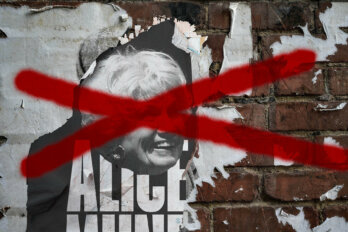On the cover of GQ’s November 2019 issue, the solemn face of Pharrell Williams emerges from the peak of an enormous bell-shaped yellow gown with dark-teal trim. The look is part angel atop the Christmas tree, part Rihanna in her oversized Raf Simons puffer coat; the feminine reference points are intentional. Inside the issue, angelic technicolour Williams shares space with an array of other “Voices of the New Masculinity,” from trans writer and sometime amateur boxer Thomas Page McBee to queer Black comedy writer and performer Jaboukie Young-White. The New Masculinity issue is an optimistic, determined attempt—and, on its own terms, a pretty successful one—to rethink what it means to be a man and to find new and better ways of doing maleness.
This isn’t a new task. But it’s an undertaking that feels both newly possible and newly urgent—possible because of the increased visibility of people like McBee and Young-White, who offer previously unavailable, potentially liberating models of maleness, and urgent because of the persistence of their reactionary counterparts: those other men, old and new, whose presence and power testifies to the ugliest, most pernicious facets of masculinity.
Those other men: there’s the old guard, some newly emboldened with the sheen of weaponized victimhood, whether at the hands of a #MeToo “witch hunt” or cancellation by the “anti-free-speech” campus left. There are the new reactionary self-styled rebels: the internet trolls, the devotees of freedom of speech expediently interpreted as freedom from consequences. And, harder to pin down, there are the faux-progressive hypocrites: the comedian who boldly proclaims his feminism on a late-night show before being accused of sexual misconduct or the prime minister whose cabinet is gender-balanced but who conveniently forgets to mention his past dalliances with brownface and blackface.
The GQ package understandably focuses on positive models of new masculinity rather than their regressive doppelgängers. The trouble is, it’s hard to know when talk of new masculinity is more than just talk. It’s easy to say, as Williams does, that “the truest definition of masculinity is the essence of you that understands and respects that which isn’t masculine”; in 2020, we all know how to speak the language of feminism, especially when doing so can net you a magazine cover. But contemporary online culture’s emphasis on voicing the right opinions, as Jia Tolentino has argued, can lull us into thinking that opinions are an adequate substitute for action. “Our world,” she writes, “makes communication about morality very easy but makes actual moral living very hard.”
In its best moments, the new masculinity discourse acknowledges this—for example, McBee’s contribution to the GQ issue, in which he describes suddenly finding, post-transition, that merely speaking in his “new baritone” can make his colleagues at work immediately hush and pay attention. The white male privilege he now wields is both seductive—there’s an immense power in being able to command attention with one’s voice—and disturbing (a tension McBee addresses at greater length in his 2018 book, Amateur: A True Story About What Makes a Man). What makes McBee’s approach so compelling is his cognizance of the fact that privilege can’t be extinguished simply by holding feminist views. Understanding and respecting that which isn’t masculine, as Williams puts it, is necessary but not sufficient. The next step involves some uncomfortable self-criticism and a willingness to implicate oneself. This doesn’t make for easy sound bites, nor does it always make for satisfied readers: McBee’s GQ story about male privilege, he later tweeted, prompted the most hate mail he received all year. The most necessary conversation about masculinity is also the conversation that makes men feel least comfortable, that provokes the most pushback.
This is demanding work, as McBee’s hate mail attests. But it feels like these conversations are finally gaining some momentum, not just in popular culture and online discourse but also in literary fiction—and no longer just literary fiction by the female, queer, and trans and nonbinary authors who have been critiquing normative masculinity in their work for years. The same span of a few months that saw the release of GQ’s New Masculinity issue also spawned Tony Tulathimutte’s “The Feminist” (a short story in the fall 2019 issue of n+1), Adnan Khan’s There Has to Be a Knife (published in September 2019), and (from a month later) Ben Lerner’s The Topeka School. All three seek to put the reader into uncomfortably close proximity with ugly masculine entitlement and toxic behaviour. These works of fiction add something important to the current conversation on masculinity. Like Tolentino and McBee, they get that it’s all too easy to fall back on the empty rhetoric of respect for femininity. If, as Tolentino argues, “communication about morality” has become rote, then perhaps we have to find new ways of communicating; perhaps, in rethinking our language, we might equip ourselves for urgent moral action. This is one way of understanding the work that literature can do.
For literature to do this, though, it first has to overcome a basic problem: How do you convince your reader to want to spend extended periods of time inside the psyches of men who are, to varying degrees, pretty awful company? In a cultural moment when we’re all too aware of how omnipresent such men are, why give them even more airtime?
It’s a dilemma that requires a stylistic balancing act. And the past several decades have provided plenty of early models for solving it, from Nabokov’s Lolita to David Foster Wallace’s Brief Interviews with Hideous Men to the fiction of Junot Díaz. The cases of the last two writers, however, both of whom have themselves been accused of treating women badly, should warn us that the link between the diagnosis of toxic masculinity and the cure is tenuous at best. Tulathimutte draws heavily on this tradition of writing: the protagonist of “The Feminist”—intensely self-conscious yet devoid of critical self-awareness—fits comfortably alongside Wallace’s “hideous men.” He’s somebody who’s read the right (feminist) books: “I’ve read Sanger and Friedan and MacKinnon and Dworkin and Firestone and Faludi and Winterson and Butler and Solanas and Schulman and hooks and Greer.” And, what’s more, he can employ the kind of progressive language that proves he’s really learned their lessons: he’s not just read the books, he’s “done the intellectual labor to empathize with a broad spectrum of female perspectives.”
Still, if the emptiness of his performance isn’t clear from the second paragraph, where we’re told that his education “ingrained in him, if not feminist values per se, the value of feminist values,” it’s unmissable by the story’s end, when, without giving too much away, it becomes clear that he no longer finds those values valuable. “The Feminist” is grappling, then, with the hypocrite: the supposed progressive who is fluent in the language of social justice but acts counter to its principles.
Like Nabokov, Wallace, and Díaz, Tulathimutte lures the reader into spending time with his abhorrent male protagonist through linguistic virtuosity. It’s partly the sheer pace of the story, which covers multiple decades in a series of vignettes: it’s like a darkest-timeline, millennial version of the opening sequence of Pixar’s Up in which Carl never meets Ellie and instead becomes an incel. The other side of Tulathimutte’s virtuosity lies in his facility with the recognizable linguistic particularities (in speech and on social media) of the urban, educated North American millennials he’s writing about. Especially noticeable are the morsels of contemporary social justice discourse: microaggressions, mansplaining, emotional labour. On one level, these reference points function as familiar signposts for the reader. But the story is ultimately more interested in putting these terms through the wringer, deforming and reforming them until they’re no longer quite so familiar.
For the protagonist, “toxic masculinity” isn’t a description of a set of behaviours in which he could ever be complicit; it’s a way to telegraph his politics, a way for him to distance himself from the “swollen alpha dickhead[s],” and ultimately, perversely, a way to tell himself that he, too, suffers under patriarchy. This is the language of liberation and resistance put to entirely self-serving ends. Hence, “The Feminist” ends up providing a very contemporary update to the Nabokov-Wallace-Díaz model of how to make the reader want to spend time with hideous men. In Lolita, Humbert Humbert’s “fancy prose style” draws the reader in only for the novel to suggest that this writerly seduction is, morally speaking, deeply suspect; similarly, in “The Feminist,” the protagonist’s aptitude with the tropes of contemporary political discourse makes for compulsive reading while also showing how that same linguistic virtuosity (and linguistic virtuousness) can be wielded as a weapon.
Language is a weapon in Adnan Khan’s latest novel too. Here’s Omar, the narrator and protagonist, assessing the damage done after an especially callous jab at the fiancé of the woman having an affair with him:
Neither of us knows if I’m joking. There is no motion to her face, her muscles steady under all that skin. I envision peeling back that topmost layer of skin to see the flesh ripple react underneath, to know that the thing I said had an impact. A blade so sharp it wouldn’t hurt, or leave a scar. I’d love to read that red flesh like you would an inkblot.
Omar is a troll, online and off. In this role, which he occupies for most of the novel’s 200-plus pages, he’s bent on provocation. The content of what he says isn’t especially important; it’s that his words pierce their target. He sees others—not exclusively but especially women—in terms of the impact he has on them. This is the dynamic that fuels the narrative of There Has to Be a Knife: informed in the opening pages that his ex-girlfriend Anna has died by suicide, Omar spends the rest of the book searching for the note he’s determined to believe she left him—a note that would register the impression he left on her. The fact that There Has to Be a Knife opens with Omar trying to catch a literal knife is therefore kind of a red herring: a knife can slice your hand open, but it’s words that do the real damage. One can come out of reading “The Feminist” thinking that words don’t matter—that even the most politically weighty language is little more than a hollow performance. There Has to Be a Knife provides a counter: sure, speaking the right words might not make you a good person, but the wrong ones have real and destructive consequences.
“It’s hard to know when talk of new masculinity is more than just talk.”
The two stories run parallel in other ways. Both feature a main character who ends up finding cheap thrills in discharging hateful language into the bowels of the internet. But, because Omar is a young Muslim man, his trolling is construed as constituting a credible terrorist threat. This sets off the novel’s second plotline, in which Omar is dragged into becoming an informant for the RCMP. On the face of it, then, There Has to Be a Knife presents as both a mystery (Where is Anna’s note, and who or what is really responsible for her death?) and a terrorism thriller about a vulnerable young Muslim coerced into informing on his community.
But Khan’s project is, in the end, a different one. He uses genre the way Tulathimutte uses pace and diction: as a hook. But the novel isn’t really much of a mystery or a thriller. Omar doesn’t have a detective’s drive for the truth or the moral convictions that would give his role as an informant a compelling sense of tension. (Moral convictions? In this economy? Omar can barely make rent, so he can hardly afford to turn down the police’s offer of cash for info.) Instead, the book is a claustrophobic and often disorienting character study and a sharp dissection of how grief—wrongly channelled and enflamed by grievance—can fuel destructive masculine behaviour, inciting flailing verbal aggression on the internet and in everyday life. Omar, like many men of his generation, feels disempowered for a mixture of reasons—some very valid, others less so. His coping strategies provide a fleeting sense of power. But, in the long run, the version of masculinity they enact causes real damage to himself and to others.
Tulathimutte and Khan both explore how words can do harm. In The Topeka School, Lerner distills this concern about hostile language to its purest form: it’s a novel about competitive debate. What’s subtext in the other two stories becomes text here: if, as we’ve been told for more than just the last few years, masculinity is in crisis, then that crisis is, at least in part, a crisis of language.
It’s no accident that, when Thomas Page McBee tells GQ about one of his first experiences of white male privilege—the commanding baritone, the silenced colleagues—it’s a scene of speech that he describes. Nor is it an accident that a scene of speech—of what would later be termed “mansplaining”—is the starting point for Rebecca Solnit’s widely circulated essay “Men Explain Things to Me” (and for her 2014 book of the same title). In no small part, it’s in what men say and how they say it that what we’ve come to know as toxic masculinity manifests itself.
Lerner’s fiction has been interested in men and their obnoxious habits of speech for a while. 2014’s 10:04—the second novel in the loose autofictional trilogy that The Topeka School completes—expertly skewers pompous male logorrhea. In that book, Lerner’s authorial stand-in observes quizzically while a “distinguished male author . . . hold[s] forth” (the same expression Solnit uses in relation to her proto-mansplainer in “Men Explain Things to Me”). The Topeka School picks up the baton: it begins with a scene in which a young man speaks at such length and with such oblivious self-assurance that he fails to notice that the woman he’s supposedly been addressing has slipped off the side of the boat he’s sitting in.
But there’s an important difference: both books take jabs at men who hold forth, but in The Topeka School, Lerner himself (or rather his fictional alter-ego, Adam) is the one yammering on until his girlfriend literally jumps ship. In the new novel, Lerner takes the McBee approach, implicating himself and taking the critical step of acknowledging that ugly male privilege isn’t the preserve of the old guard and the obvious reactionaries: it’s close to the surface even in those who (like Adam—and like Wallace and Díaz) are able to diagnose toxic masculinity in others.
For all the moments of ugliness, The Topeka School is a less sour read than “The Feminist” and less claustrophobic than There Has to Be a Knife. Lerner’s novel is a more expansive, many-voiced project. Alternating between four different perspectives—Adam, his father, one of his former schoolmates, and crucially, his mother—the novel is a wide-ranging critique of the many different forms of speech into which young, white American men channel their insecurities and animosities, from high school debate to freestyle rap. But it also nudges these masculinized habits of linguistic combat into dialogue with gentler, cooler, and wittier ways of relating to the world. This is most evident in the sections told by Adam’s mother, Jane—for example, when she hits on a technique for dealing with the misogynist trolls who call her to rail against her feminist books: instead of responding with anger or fear, she merely pretends to not be able to hear. Forced to repeat themselves, the trolls are left flailing, their verbal knives lashing wildly at the air.
The Topeka School grapples with toxic masculinity directly and honestly, but it also gestures more clearly toward what it might look like to emerge on the other side. What Lerner, Tulathimutte, and Khan make clear is that proficiency in the language of progressive politics and feminism isn’t any kind of solution. A mastery of feminist vocabulary can easily coexist with, or even provide cover for, destructive masculine behaviour. Instead, Lerner suggests, men invested in reimagining masculinity ought to radically reconceive our entire idea of language. We need to unlearn the pervasive, often unconscious idea that speech is a form of linguistic combat, a way to shore up one’s own power. That’s what’s toxic about the virtue signalling of “The Feminist,” about Omar’s trolling, and about The Topeka School’s high school debate: they’re ways to talk at, rather than with, other people—means of competition rather than cooperation.
What would it look like to leave these habits behind? What does nontoxic, cooperative speech sound like? The final sentences of The Topeka School give us one possible answer:
One of the organizers stood on a stone bench and yelled, “Mic check,” and we all yelled it back. The “human microphone,” the “people’s mic,” wherein those gathered around a speaker repeat what the speaker says in order to amplify a voice without permit-requiring equipment. It embarrassed me, it always had, but I forced myself to participate, to be part of a tiny public speaking, a public learning slowly how to speak again . . .





